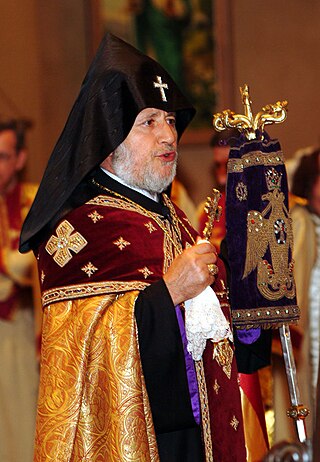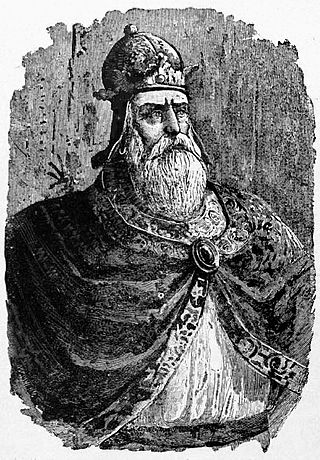
Patriarchate is an ecclesiological term in Christianity, designating the office and jurisdiction of an ecclesiastical patriarch. According to Christian tradition three patriarchates were established by the apostles as apostolic sees in the 1st century: Rome, Antioch, and Alexandria. Constantinople was added in the 4th century and Jerusalem in the 5th century. Eventually, together, these five were recognised as the pentarchy by the Council of Ephesus in 431.

The Catholicos of All Armenians, is the chief bishop and spiritual leader of Armenia's national church, the Armenian Apostolic Church, and the worldwide Armenian diaspora. According to tradition, the apostles Saint Thaddeus and Saint Bartholomew brought Christianity to Armenia in the first century. Saint Gregory the Illuminator became the first Catholicos of All Armenians following the nation's adoption of Christianity as its official religion in 301 AD. The seat of the Catholicos, and the spiritual and administrative headquarters of the Armenian Church, is the Mother See of Holy Etchmiadzin, located in the city of Vagharshapat.
An apostolic see is an episcopal see whose foundation is attributed to one or more of the apostles of Jesus or to one of their close associates. In Catholicism the phrase, preceded by the definite article and usually capitalized, refers to the See of Rome.

Tiridates III, also known as Tiridates the Great, or Tiridates IV, was the Armenian Arsacid king from c.298 to c. 330.

The association of Armenians with India and the presence of Armenians in India are very old, and there has been a mutual economic and cultural association of Armenians with India.

Catholicos Karekin II is the current Catholicos of All Armenians, the supreme head of the Armenian Apostolic Church. In 2013 he was unanimously elected the Oriental Orthodox head of the World Council of Churches for the next eight years.

The Armenian Church of Saint Gregory the Illuminator, referred to locally as the Armenian Church, is the oldest Christian church in Singapore, located at Hill Street in the Museum Planning Area, within the Central Area. The church was completed in 1835 and consecrated the next year. Originally a parish of the Armenian Apostolic Church, an Oriental Orthodox denomination, the last Armenian parish priest left in the late 1930s as Armenian population in Singapore dwindled. It was designated as a national monument in 1973. Armenian and Oriental Orthodox services are now regularly held at the church.
Armenians in the Middle East are mostly concentrated in Iran, Lebanon, Cyprus, Syria, Jordan, Saudi Arabia and Jerusalem, although well-established communities exist in Iraq, Egypt, Turkey and other countries of the area including, of course, Armenia itself. They tend to speak the western dialect of the Armenian language and the majority are adherents of the Armenian Apostolic Church, with smaller Catholic and Protestant minorities. There is a sizable Armenian population in the thousands in Israel. There is also the Armenian Quarter in Jerusalem with a history that goes back 2,000 years.
The first Armenians in Burma arrived in 1612, and dwelt in Syriam, the first tombstone being dated 1725. They were merchants.

Christianity in Azerbaijan is a minority religion. Christians who estimated between 280,000 and 450,000 (3.1%–4.8%) are mostly Russian and Georgian Orthodox and Armenian Apostolic. There is also a small Protestant Christian community which mostly came from Muslim backgrounds.

The Armenians in Singapore are a small community who had a significant presence in the early history of Singapore. They were among the earliest merchants to arrive in Singapore were from the British Raj when it was established as a trading port by Sir Stamford Raffles in 1819. They numbered around 100 individuals at their peak in the early 1920s, but most have moved on to other countries or become absorbed into the wider Singapore community. Despite their small number, they had an impact in the commercial life of early Singapore and members of the community co-founded the newspaper The Straits Times and built the Raffles Hotel. The Armenian Apostolic Church of St Gregory the Illuminator on Armenian Street, the second church to be built in Singapore, is today the oldest surviving one.

The term Eastern Protestant Christianity encompasses a range of heterogeneous Protestant Christian denominations that developed outside of the Occident, from the latter half of the nineteenth century, and yet keep elements of Eastern Christianity, to varying degrees. Some of these denominations came into being, when existing Protestant churches adopted reformational variants of Eastern and Oriental Orthodox liturgy and worship. Some others are the result of reformations of Orthodox beliefs and practices, inspired by the teachings of Western Protestant missionaries. Some Eastern Protestant Churches are in communion with similar Western Protestant Churches. However, Eastern Protestant Christianity does not constitute a single communion. This is due to the diverse polities, practices, liturgies and orientations of the denominations which fall under this category.

Christianity in Myanmar has a history dating to the early 18th century. According to the 2016 census, Christianity is the country's second largest religion, practiced by 6.3% of the population, primarily among the Kachin, Chin and Kayin, and Eurasians because of missionary work in their respective areas. About four-fifths of the country's Christians are Protestants, in particular Baptists of the Myanmar Baptist Convention; Roman Catholics make up the remainder.

Christianity in Russia is the most widely professed religion in the country. The largest tradition is the Russian Orthodox Church. According to official sources, there are 170 eparchies of the Russian Orthodox Church, 145 of which are grouped in metropolitanates. There are from 500,000 to one million Old Believers, who represents an older form of Russian Orthodox Christianity, and who separated from the Orthodox Church in the 17th century as a protest against Patriarch Nikon's church reforms.

The Oriental Orthodox Churches are Eastern Christian churches adhering to Miaphysite Christology, with approximately 60 million members worldwide. The Oriental Orthodox Churches are part of the Nicene Christian tradition, and represent one of its oldest branches.

The Forty Martyrs Armenian Cathedral of Aleppo, Syria, is a 15th-century Armenian Apostolic church located in the old Christian quarter of Jdeydeh. It is significant among the Armenian churches for being one of the oldest active churches in the Armenian diaspora and the city of Aleppo. It is a three-nave basilica church with no dome. Its bell tower of 1912, is considered to be one of the unique samples of the baroque architecture in Aleppo.
Mikołaj Torosowicz, was the first Armenian Catholic bishop of Lviv.












